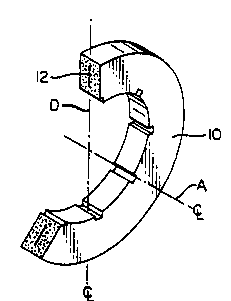Some of the information on this Web page has been provided by external sources. The Government of Canada is not responsible for the accuracy, reliability or currency of the information supplied by external sources. Users wishing to rely upon this information should consult directly with the source of the information. Content provided by external sources is not subject to official languages, privacy and accessibility requirements.
Any discrepancies in the text and image of the Claims and Abstract are due to differing posting times. Text of the Claims and Abstract are posted:
| (12) Patent Application: | (11) CA 2101636 |
|---|---|
| (54) English Title: | CARBON COMPOSITE BRAKE DISC WITH POSITIVE VIBRATION DAMPING |
| (54) French Title: | DISQUE DE FREIN COMPOSITE AU CARBONE AVEC AMORTISSEMENT DES VIBRATIONS |
| Status: | Deemed Abandoned and Beyond the Period of Reinstatement - Pending Response to Notice of Disregarded Communication |
| (51) International Patent Classification (IPC): |
|
|---|---|
| (72) Inventors : |
|
| (73) Owners : |
|
| (71) Applicants : |
|
| (74) Agent: | MACRAE & CO. |
| (74) Associate agent: | |
| (45) Issued: | |
| (86) PCT Filing Date: | 1992-01-21 |
| (87) Open to Public Inspection: | 1992-08-15 |
| Availability of licence: | N/A |
| Dedicated to the Public: | N/A |
| (25) Language of filing: | English |
| Patent Cooperation Treaty (PCT): | Yes |
|---|---|
| (86) PCT Filing Number: | PCT/US1992/000480 |
| (87) International Publication Number: | US1992000480 |
| (85) National Entry: | 1993-07-29 |
| (30) Application Priority Data: | ||||||
|---|---|---|---|---|---|---|
|
2101636 9214946 PCTABS00015
A carbon composite aircraft brake disc (10, 50, 60, 110, 120) is
manufactured to include internally an insert member (12, 14, 18,
24, 28, 32, 36, 42, 52, 115, 125) which effects positive
vibration damping for the disc (10, 50, 60, 110, 120) during operation of
the brake (100). The insert member (12, 14, 18, 24, 28, 32, 36,
42, 52, 115, 125) may be a graphite material, paper, or cloth
material which is introduced into the interior of material utilized
for manufacturing the carbon composite aircraft disc (10, 50, 60,
110, 120). After manufacturing of the brake disc (10, 50, 60,
110, 120) is completed, the brake disc comprises a single integral
carbon composite brake disc (10, 50, 60, 110, 120) having
disposed completely internally therein the insert member which provides
a discontinuity that effects efficiently positive vibration
damping of the disc (10, 50, 60, 110, 120) during operation of the
aircraft brake (100) in which the disc is located.
Note: Claims are shown in the official language in which they were submitted.
Note: Descriptions are shown in the official language in which they were submitted.

2024-08-01:As part of the Next Generation Patents (NGP) transition, the Canadian Patents Database (CPD) now contains a more detailed Event History, which replicates the Event Log of our new back-office solution.
Please note that "Inactive:" events refers to events no longer in use in our new back-office solution.
For a clearer understanding of the status of the application/patent presented on this page, the site Disclaimer , as well as the definitions for Patent , Event History , Maintenance Fee and Payment History should be consulted.
| Description | Date |
|---|---|
| Inactive: IPC from MCD | 2006-03-11 |
| Inactive: IPC from MCD | 2006-03-11 |
| Time Limit for Reversal Expired | 2000-01-21 |
| Application Not Reinstated by Deadline | 2000-01-21 |
| Deemed Abandoned - Failure to Respond to Maintenance Fee Notice | 1999-01-21 |
| Inactive: Abandon-RFE+Late fee unpaid-Correspondence sent | 1999-01-21 |
| Application Published (Open to Public Inspection) | 1992-08-15 |
| Abandonment Date | Reason | Reinstatement Date |
|---|---|---|
| 1999-01-21 |
The last payment was received on 1997-12-31
Note : If the full payment has not been received on or before the date indicated, a further fee may be required which may be one of the following
Patent fees are adjusted on the 1st of January every year. The amounts above are the current amounts if received by December 31 of the current year.
Please refer to the CIPO
Patent Fees
web page to see all current fee amounts.
| Fee Type | Anniversary Year | Due Date | Paid Date |
|---|---|---|---|
| MF (application, 6th anniv.) - standard | 06 | 1998-01-21 | 1997-12-31 |
Note: Records showing the ownership history in alphabetical order.
| Current Owners on Record |
|---|
| ALLIED-SIGNAL INC. |
| Past Owners on Record |
|---|
| MCALLISTER LAWRENCE EDWARD |
| DAVID ROSS SNYDER |
| JARING VANDER VEEN |